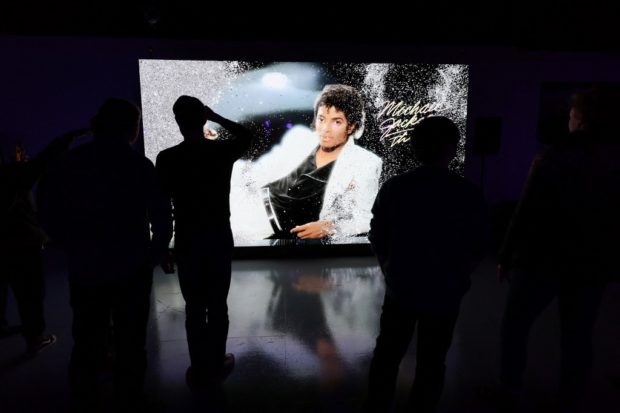Michael Jackson’s ‘Thriller’ revolution turns 40

Guests attend the Michael Jackson Thriller 40 Immersive Experience honoring the 40th anniversary of “Thriller” at Center 415 on Nov. 18, 2022, in New York City. DIA DIPASUPIL/Getty Images/via AFP
PARIS, France—Mixing rock, pop, and RnB like never before, Michael Jackson’s “Thriller,” 40 years old next week, became the most successful album of all time and defined a coming era with its audiovisual ambition.
“Thriller” has sold more than 100 million copies worldwide since its release on Nov. 30, 1982.
It consecrated Jackson as the “King of Pop” and remains a musical lodestone.
Even renewed allegations of pedophilia in the 2019 documentary “Leaving Neverland” failed to dent his popularity, and Jackson’s reach has continued to grow, with his music currently ranked 60th in the world on Spotify with 36.7 million monthly streams.
His influence is still all over the charts, not least in the form of The Weeknd, whose music has channeled Jackson, from an early cover of “Dirty Diana” (2010’s “DD”) through to his recent chart-topping album “Dawn FM.”
“Michael is somebody that I admire. He’s not like a real person, you know? When I started making music, that’s all I wanted to aspire to, just like every other musician,” the Canadian singer-songwriter told GQ magazine recently.
Much of the magic on “Thriller” is thanks to producer Quincy Jones, who had worked with Jackson on 1979’s “Off the Wall.”
“The record company didn’t want Quincy for ‘Off The Wall.’ They took a dim view of this producer from the jazz world–music that sold peanuts in the eyes of the industry,” said Olivier Cachin, author of two books on Jackson.
But the collaboration saw sparks fly–literally on one occasion.
“When we were finishing ‘Beat It’… we were working five nights and five days, with no sleep. And at one point, the speakers overloaded and caught on fire!” Jones recalled to Rolling Stone.
Threatening MTV
“Thriller” was the moment when Jackson started to pull in influences from across pop culture, with Eddie Van Halen’s hard rock solo on “Beat It,” and pop ballad “The Girl Is Mine” with Paul McCartney.
There were pioneering rap rhythms on “Wanna Be Startin’ Somethin'” and a sample from “Soul Makossa” by saxophonist Manu Dibango (who got a large pay-out after Jackson’s team failed to secure authorization).
Initially, the record failed to break on to the newly established MTV channel, which refused to show the video for megahit single “Billie Jean” on the grounds that black music did not “fit” with its white-dominated rock programming.
The boss of Jackson’s parent label at CBS, Walter Yetnikoff, “threatened to publicly denounce MTV as huge racists and block their access to videos of rock artists in its catalogue,” said Cachin.
Yetnikoff won that battle but then found himself clashing with Jackson over his plans for a $1-million video for the album’s last single, the title track “Thriller.”
Jackson wanted to work with director John Landis, having loved his movie “An American Werewolf in London,” while Yetnikoff thought the plan was pointless when the album was already at number one.
“But Michael had a vision, and he was stubborn,” said Cachin.
The resulting 14-minute mini-film was premiered at a Hollywood cinema before a star-packed crowd and helped re-energize sales of the album.
Not only did it see Jackson turn into a werewolf and bring the living dead out of their graves, but also launched a whole new branch of the music business–extravagant and ambitious videos that came to define the next two decades of pop culture.